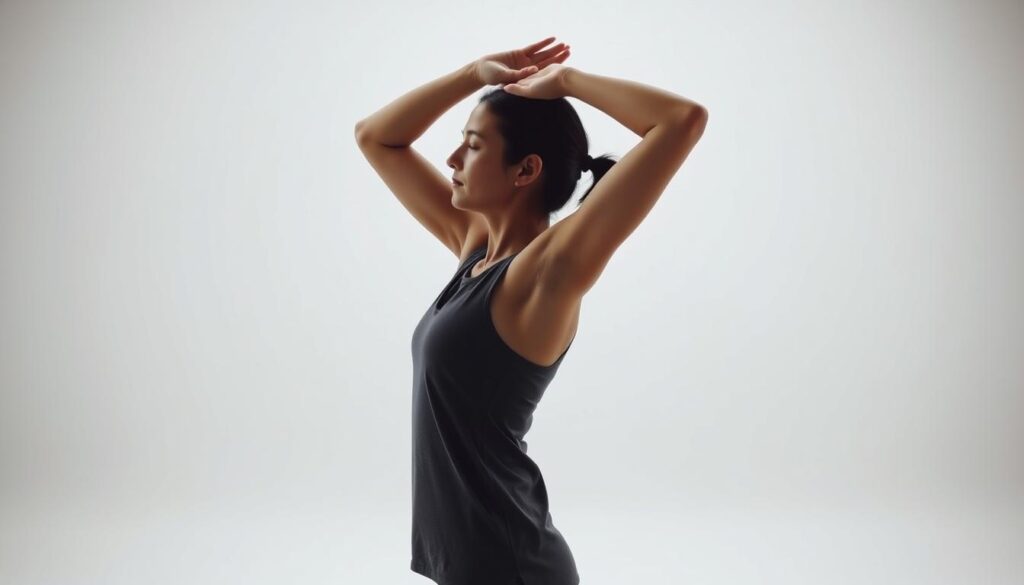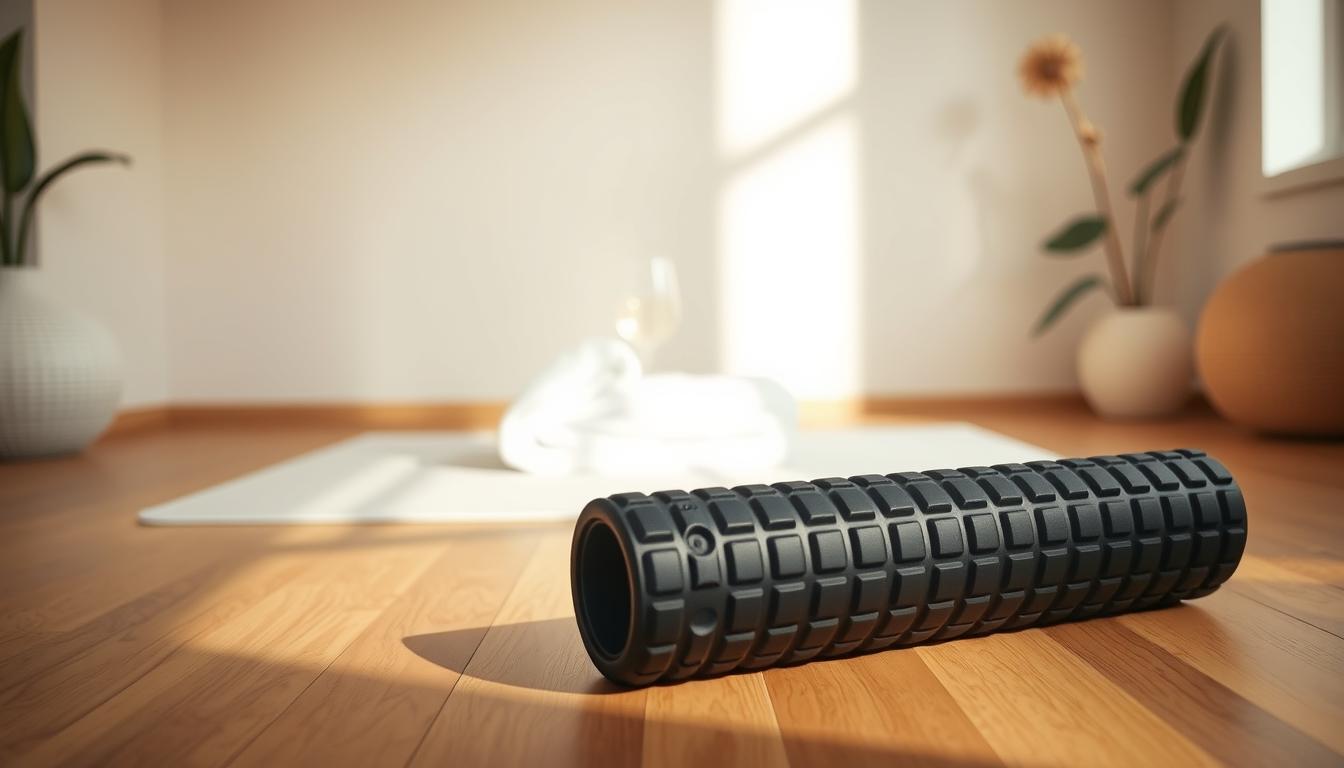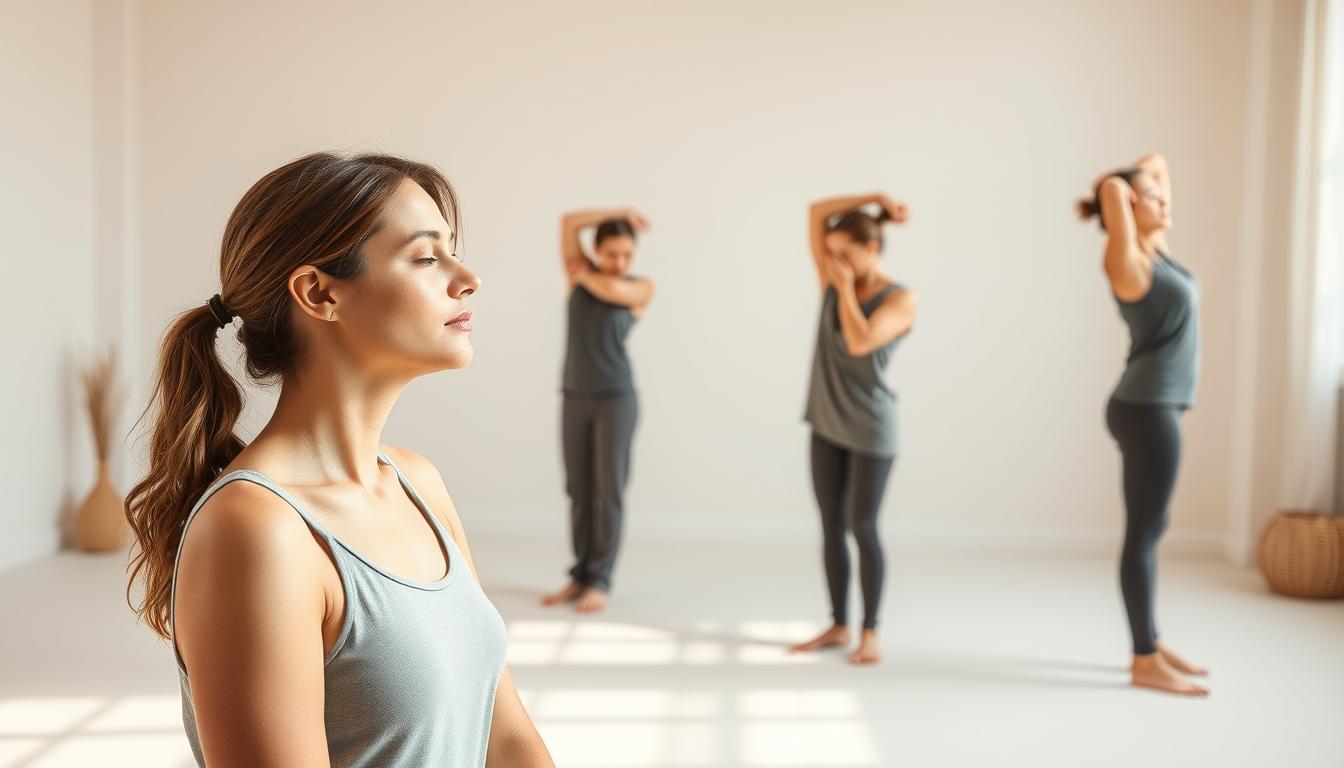As workplaces change, more people are sitting at desks for long hours. This causes neck tension to increase. Desk exercises designed for easing neck tension are key for your well-being.
Adding easy, helpful stretches to your day helps reduce pain and improve your posture. It’s important to focus on wellness at work to fight the downsides of sitting too much. These exercises should be an essential part of your office routine.
Understanding Neck Tension in the Workplace
More and more people working in offices face neck tension today. This issue can hurt how much work you get done and your health. It’s important to find out why you’re feeling this tension to help fix it.
Common Causes of Neck Tension
A few key things lead to neck tension at work, such as:
- Poor posture during prolonged sitting
- Non-ergonomic desk setups
- Repetitive motions associated with desk tasks
- Extended periods of immobility
A big number of workers feel discomfort from these issues while at their desks. If not addressed, this discomfort can grow into bigger health problems.
Statistics on Desk Jobs and Neck Pain
About 80% of American workers sit all day for their job. This fact shows we need to pay attention to how work affects our neck. A lot of people say their office life causes neck pain. Preventive actions are crucial to avoid serious health issues.
Desk-Friendly Exercises for Neck Tension Relief
Adding stretching to your day helps ease neck tension and keep your neck healthy. Moving regularly, like doing simple stretches, boosts blood flow and flexibility. This not only lessens pain but also helps you stress less.
Effective Stretches You Can Do at Your Desk
Stretching during work breaks is good for your posture and movement. Try these easy stretches as part of your routine:
- Neck rolls—gently move your head in a circular motion.
- Shoulder shrugs—lift and lower your shoulders to relieve tension.
- Forward neck stretch—gently tilt your head forward to stretch the back of your neck.
Importance of Regular Movement for Neck Health
Moving around at work is key for keeping your neck in good shape. Doing stretches often not only stops stiffness but also makes the workplace healthier. Moving more also helps you deal with stress, stay focused, and avoid long-term pain from sitting too much.
Simple Shoulder Shrugs
Shoulder shrugs are a great way to improve posture and ease neck and shoulder tension. They’re perfect for your desk job and help keep you feeling good. By doing them regularly, you can avoid the downsides of sitting too long.
How Shoulder Shrugs Improve Posture
Shoulder shrugs work by fixing how your shoulders sit, which fights against slouching. Doing them often helps pull your shoulders into a healthier position. This not only feels better but also helps you breathe better and boosts your energy for the day.
Step-by-Step Instructions for Doing Shrugs
To do shoulder shrugs right and reap their benefits, just follow these easy steps:
- Stand or sit up straight to start.
- Breathe in and lift your shoulders up high.
- Hold it for a bit, feeling the stretch in your neck and shoulders.
- Breathe out and lower your shoulders back down.
- Do this 10 times to make it part of your daily routine.
Side-to-Side Neck Tilts
Adding side-to-side neck tilts to your daily habits can make your neck more flexible. These stretches are great for loosening up tight muscles. They help you keep a good posture while working at your desk. Doing this stretch often keeps your neck in good shape and lessens pain from sitting too much.
Benefits of Side Tilts for Neck Flexibility
Side tilts for the neck bring many benefits. They are key to:
- Increasing the neck’s movement range.
- Easing tightness in neck and shoulder areas.
- Making your posture and body alignment better.
Tips for Holding the Stretch Correctly
To do neck tilts the right way:
- Sit in a chair with your back straight and feel comfy.
- Lean your head towards one shoulder gently, keeping the other shoulder relaxed.
- Stay in this pose for 15-30 seconds, breathing as usual.
- Then, do the same on the other side.
- Don’t push too hard or bounce, to avoid getting hurt.
Chin to Shoulder Stretch
The chin to shoulder stretch helps relax your neck and shoulder muscles. It’s a simple move that brings a lot of relief, especially if you sit for long periods. Doing this stretch often improves flexibility and helps with discomfort from sitting too much.
How to Properly Execute the Chin to Shoulder Stretch
To do the chin to shoulder stretch, here’s what you should do:
- Sit or stand up straight, keeping your shoulders relaxed.
- Slowly move your chin towards one shoulder.
- Use the hand on that side to gently push for a deeper stretch.
- Stay in this position for 5-10 seconds.
- Gently release and switch to the other side, repeating as needed.
It’s important to keep your posture right to avoid any strain. Move smoothly and focus on feeling the stretch comfortably.
Expected Benefits and Duration of the Stretch
This stretch eases tension in your neck and shoulders. If you do it regularly, it can lessen stiffness and increase flexibility. It only takes 5-10 seconds on each side, making it a quick fix for desk-related discomfort. Keeping up with this stretch can greatly improve your motion range and decrease daily tension.
Opening the Shoulders and Chest
Good posture is key for people who sit at desks, as it keeps tension away and boosts well-being. Stretching your chest opens your shoulders, improving how you sit and stand. Doing these stretches helps your body line up right and stay flexible, fighting the downsides of sitting too long.
Why Good Posture Matters
Having good posture is like having a strong base for your spine and body movement. It lessens the pressure on muscles and joints and helps blood flow better. This matters a lot for anyone who spends hours bent over a desk. Using shoulder stretches makes you feel more comfortable while working.
Steps to Perform the Chest Opener Stretch
- Begin by standing or sitting up straight.
- Clasp your hands behind your back, interlacing fingers.
- Gently lift your hands upward while rolling your shoulders back and down.
- Hold this position for 15 to 30 seconds, focusing on deep breathing.
- Release and return to your starting position.
Adding this stretch to your daily routine boosts shoulder flexibility and supports a better posture. It offers great ergonomic benefits. Regularly practicing chest stretches eases tightness and makes you feel better all around.

Alternate Stretches for Arm and Torso Relief
Adding arm stretches and torso twists to your daily life can make a big difference. These exercises can ease tension and help you stand straighter. This is especially good for those who sit a lot for work.
Triceps Stretch Technique
The triceps stretch is simple but very powerful. Lift one arm up and bend it so your hand touches the opposite shoulder blade. Use your other hand to gently pull the elbow to feel more stretch. This stretch focuses on your upper arms and reduces stress, improving flexibility and posture.
Benefits of Torso Rotation for Overall Wellbeing
Doing torso rotation exercises does wonders for your spine’s flexibility. You can do this by standing or sitting straight, with arms by your sides or crossed over your chest. Then, slowly turn your upper body from one side to the other. These movements make your core muscles stronger and improve your posture, which is great for your health.
Additional Quick Exercises to Combat Neck Tension
Quick exercises can fight neck tension well, especially for desk workers. Yoga exercises like cat-cow and child’s pose help a lot. They make your neck feel better and your shoulders less tight.
Yoga Poses for Tech Neck Relief
Yoga poses can change how we handle neck tension. The cat-cow stretch makes your spine more flexible and less tight. Child’s pose helps you stress less and find peace in a busy day. Adding these poses to your daily routine is great for your neck.
Importance of Breathing Techniques During Stretches
Breathing right when you stretch makes exercises work better. It helps you stretch further and relax more. Breathing in sync with movement lowers tension and brings calmness. This not only helps your body but also makes your mind clearer and more focused.
Conclusion
In summary, effective desk exercises are key to reducing neck tension and improving overall health at work. These exercises, like shoulder shrugs and torso rotations, are simple. They help relieve discomfort and support better posture while sitting at a desk.
When you focus on these exercises, you’re building a foundation for healthier necks in the long run. This summary shows that easy ergonomic steps can change how your work area affects your health. Moving regularly fights off the bad impacts of sitting too much.
Adding these methods to your daily routine can majorly boost your comfort and how much you get done. This is a chance to make your workday healthier and more full of energy. Enjoy the perks of feeling better and being more productive.



